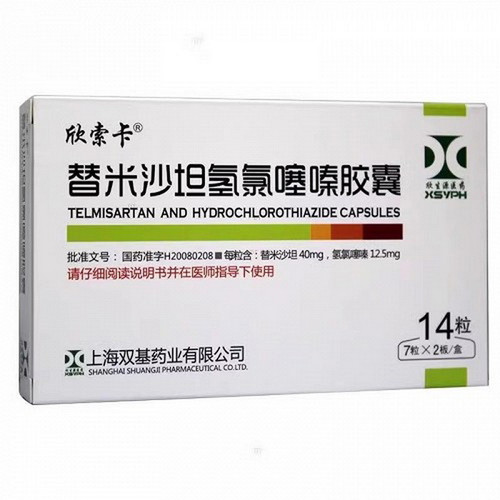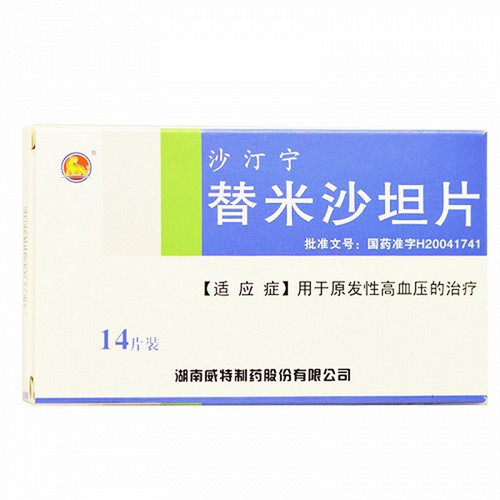Product Overview
[Drug Name]
Generic Name: Telmisartan Hydrochlorothiazide Tablets
Trade Name: Xintongping Telmisartan Hydrochlorothiazide Tablets 40mg: 12.5mg * 14 tablets
Pinyin Full Code: XinTongPing TiMiShaTanQingLvZuoZuoPian 40mg: 12.5mg * 14 tablets
[Main Ingredient]
Telmisartan Hydrochlorothiazide
[Indications/Main Functions]
For the treatment of essential hypertension. Mikasu fixed-dose combination (telmisartan 80mg/hydrochlorothiazide 12.5mg) is indicated for the treatment of patients whose blood pressure is not adequately controlled with telmisartan alone.
[Specifications]
40mg: 12.5mg * 14 tablets
[Dosage and Administration]
Adults: For adult patients whose blood pressure is not adequately controlled with telmisartan alone, Mikasu should be administered once daily with water, either before or after meals. It is recommended that the doses of both components of the combination preparation be titrated separately before switching to a combination preparation. If appropriate, switching directly from telmisartan monotherapy to a combination preparation may also be considered. For patients whose blood pressure cannot be adequately controlled with telmisartan 80 mg, Mikasartan 80/12.5 mg can be administered. Use in Renal Impairment: Regular monitoring of renal function is recommended (see Precautions). Use in Hepatic Impairment: For patients with mild to moderate hepatic impairment, the dose should not exceed Mikasartan 40/12.5 mg once daily. For patients with severe hepatic impairment, Mikasartan should not be used. Thiazide diuretics should be used with caution in patients with hepatic impairment (see Precautions). Use in the Elderly: No dose adjustment is required. Use in Children and Adolescents: The safety and efficacy of Mikasartan in children and adolescents up to 18 years of age have not been established.
[Adverse Reactions]
In a randomized controlled trial of fixed-dose combination preparations, the overall incidence of adverse events reported was similar between the Mikasu treatment group and the telmisartan monotherapy group. This randomized controlled trial enrolled 1471 patients, of whom 835 received telmisartan plus hydrochlorothiazide and 636 received telmisartan monotherapy. The trial was unable to determine a dose-related relationship for adverse events, and adverse events were not associated with gender, age, or race. Adverse reactions reported in all clinical trials with a significantly higher incidence in the telmisartan plus hydrochlorothiazide group compared to the placebo group (p<0.05) are listed below by system organ class. Adverse reactions known to occur with either of the components of Mikasu (telmisartan or hydrochlorothiazide) administered alone but not observed in clinical trials may occur during treatment with Mikasu. The frequency of adverse reactions was graded using the following criteria: very common (>1/10); common (>1/100, <1/100); uncommon (>1/1,000, <1/100); rare (>1/10,000, <1/1000); and very rare (<1/10,000). Autonomic nervous system Common: impotence General, systemic disorders Common: back pain, flu-like symptoms, pain Uncommon: allergies, leg pain Central and peripheral nervous system Common: dizziness, vertigo Gastrointestinal system Common: abdominal pain, diarrhea, dyspepsia, gastritis Uncommon: gastrointestinal disorders Metabolic and nutritional system Common: hypercholesterolemia, hypokalemia Uncommon: poorly controlled diabetes, hyperuricemia Musculoskeletal system Common: arthralgia, arthritis, myalgia Psychiatric system Common: anxiety Respiratory system Common: bronchitis, pharyngitis, sinusitis, upper respiratory tract infection Skin and accessory system Common: eczema Uncommon: skin dysfunction Urinary system Common: urinary tract infection As with other angiotensin II antagonists, isolated cases of angioedema, urticaria, and other related reactions have been observed during treatment with Mikasol. Laboratory tests The changes in laboratory test results observed in the clinical trials of Mikasol are included above (see [Precautions]). Additional Information About the Two Components of Mikasol: Adverse reactions previously reported with either component of Mikasol may also be potential adverse reactions with Mikasol treatment, even if not observed in the Mikasol clinical studies. Telmisartan: The incidence of adverse reactions with telmisartan was similar to that with placebo. The overall incidence of adverse events reported in placebo-controlled clinical trials was 41.4% in the telmisartan group and 43.9% in the placebo group, and was generally similar between the two groups. The adverse drug reactions listed in the table below are based on cumulative cases from all clinical trials of telmisartan treatment, which included a total of 5,788 hypertensive patients receiving telmisartan: Overall, systemic disorders Common: back pain (e.g., sciatica), chest pain, flu-like symptoms, symptoms of infection (e.g., urinary tract infection, including cystitis) Uncommon: visual abnormalities, increased sweating Central and peripheral nervous system Uncommon: dizziness Gastrointestinal system Common: abdominal pain, diarrhea, dyspepsia, gastrointestinal disorders Uncommon: dry mouth, flatulence Musculoskeletal system Common: arthralgia, leg cramps or leg pain, myalgia Uncommon: tendinitis-like symptoms Psychiatric system Uncommon: anxiety Respiratory system Common: upper respiratory tract infection, including pharyngitis and sinusitis Skin and appendage system Common: eczema-like skin disorders In addition, since the marketing of telmisartan, rare cases of erythema, pruritus, asthenia, insomnia, depression, gastric discomfort, vomiting, hypotension, bradycardia, tachycardia, dyspnea, eosinophilia, thrombocytopenia, weakness, and lack of efficacy have been reported. Laboratory Tests: Occasionally, the frequency of decreased hemoglobin or increased serum uric acid was higher in the telmisartan group than in the placebo group. Increased serum creatinine or liver enzymes were also observed in the telmisartan group, but the frequency of these laboratory test changes was similar to or lower than that in the placebo group (see [Precautions]). Hydrochlorothiazide: Hydrochlorothiazide can cause or worsen volume depletion, leading to electrolyte imbalances (see [Precautions]). Adverse events reported with hydrochlorothiazide used alone include: Gastrointestinal System: Anorexia, loss of appetite, gastric irritation, diarrhea, constipation, sialadenitis, pancreatitis; Hepatobiliary jaundice (intrahepatic cholestatic jaundice); Eye: Xanthoopia, transient blurred vision; Blood and Lymphatic System: Leukopenia, neutropenia/agranulocytosis, thrombocytopenia, aplastic anemia, hemolytic anemia, bone marrow suppression; Skin and Subcutaneous Tissue: Photosensitivity reaction, rash, epidermal lupus erythematosus-like reaction, epidermal lupus erythematosus reactivation (vasculitis, cutaneous vasculitis), allergic reaction, toxic epidermal necrolysis; General: Fever; Respiratory System: Respiratory distress (including pneumonia and pulmonary edema); Renal and Urinary System: Renal impairment, interstitial nephritis; Musculoskeletal: Muscle spasm, weakness; Nervous System: Restlessness, dizziness, vertigo, paresthesia; Vascular: Orthostatic hypotension; Cardiac: Arrhythmia; Psychiatric Sleep disorders, depression Laboratory tests Hyperglycemia, glycosuria, hyperuricemia, electrolyte imbalance (including hyponatremia and hypokalemia), increased blood cholesterol and triglycerides.








